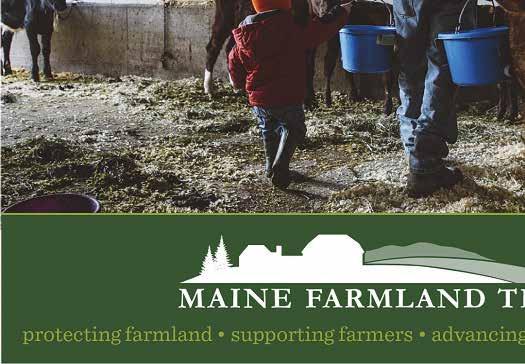








I want to express my sincere thanks to everyone reading this who is committed to supporting Maine agriculture. You are helping to create momentum and impact by investing your dollars in the farmers and producers who grow, produce, create goods and products, or provide services. Your purchases at local markets and shops, in-person at farmstands and farmers’ markets, and by ordering dishes featuring local ingredients at your favorite restaurants are good for Maine agriculture in multiple ways. Buying local products and looking for the Real Maine logo puts and keeps more money into the local economy, which is a win for farmers and consumers. On behalf of farmers across Maine, thank you.
At DACF, we are fortunate to have a dedicated team that is passionate about promoting agriculture and helping farmers succeed. Earlier this winter, I introduced our new Bureau of Agriculture, Food and Rural Resources Director, Craig Lapine. Craig accepted his appointment after Nancy McBrady transitioned from Bureau Director to Deputy Commissioner. Nancy served as Bureau Director starting in 2019. Craig joined DACF in 2020 to support our policy and communications team and manage projects, including leading the Ending Hunger in Maine by 2030 initiative.
Another person joining the DACF team is Jo D. Saffeir, who stepped into the role of Special Assistant to the Commissioner. Jo D. has a long-standing reputation as an effective and trusted facilitator and project manager over the past
30 years in the natural resource sector and beyond and has been deeply involved in the Maine Climate Council’s Natural and Working Lands work group and its ongoing work.


Another recent key addition to the DACF team is Beth Valentine, our PFAS Fund Director. The $60 million PFAS Fund, proposed by Governor Mills and passed by the State Legislature, will provide direct relief to Maine farmers impacted by PFAS contamination. Beth oversees the administration and coordination of the PFAS Fund, works with the PFAS Advisory Committee, leads planning to establish funding priorities, and oversees the implementation of programs to allocate funds.



DACF is committed to supporting Maine's food system and agricultural infrastructure and those who operate them for the long term. Again, I thank everyone for looking for ways to support Maine agriculture. Doing so today ensures that multi-generational farms, aspiring and beginning farmers, and future generations will be stepping into a more profitable and sustainable industry. Please follow DACF on social media, attend the many spring and summer agri-tourism events included in this insert and on RealMaine.com, and look to our careers webpage on maine.gov/dacf to see if there is a role you can fill in our dynamic department. We post new opportunities routinely.
Thank you again for caring about Maine agriculture.




















































With spring planting season upon us, what should gardeners know about soil health? We asked Matt Boucher, Maine’s state soil scientist, to fill us in. Boucher said his role “ranges from developing assistance programs for farmers … to providing education and outreach to Mainers.” The common thread in his work for the state is “to help Mainers connect better with the soil we occupy, and to demonstrate how the tremendous beauty of our state would not be possible without our soil.”












Soil is not a renewable resource, and if we do not take care of it, we will lose it. The topsoil is rich with nutrients that aren’t necessarily available deeper in the soil and using that soil without replenishing or conserving those nutrients will make it harder and harder to produce food at the scale we need to survive. Soil erodes when left bare, and that soil eventually makes its way to waterways, where we cannot recover it. The process of turning rocks into soil happens on the scale of thousands to millions of years, and we are losing soil far faster than it can be replenished.
Soil health is not just an agricultural issue — we use it for infrastructure, recreation, and a host of other activities. Think about the fertilizers and pesticides you apply to your yard to maintain your lawn. Is that soil healthy if it cannot sustain your lawn without external inputs? Soils do best when diverse life lives on and in it — the everyday decisions we make affect it. Small changes to make soil healthier in our homes and gardens can lead to big benefits over time.


Is there something gardeners shouldn’t do as a soil practice?






Do not leave your soil bare! When you reach the end of the season, leave the plant residue on the soil surface. This residue contains valuable nutrients that the plant removed from the soil and letting it decay in the garden returns those nutrients to the soil while protecting that soil from eroding and structural malformation.















Many folks will choose to buy topsoil and compost and use that for raised beds. I would not encourage anyone to dig up a portion of their land to build raised beds — instead purchase soil in bulk from your local nursery. The soil should be dark brown to blackish, and when you pick up a handful, it should be pretty crumbly, with small, spherical granules that break apart relatively easily. Avoid any soil that has a lot of sand and soils high in clay. Mix some compost with the soil you purchase to provide some quality nutrients for your plants.























Celebrate by visiting a sugarhouse








March 25-26









It is a well-known rite of spring and tradition for many Maine families – making the trip to sugarhouses for Maine Maple Sunday®. This year marks the 40th anniversary of the event, the first of its kind in the nation.
The 2023 edition of Maine Maple Sunday® weekend will be held March 25 and 26. Some sugarhouses will be open both days, while others may be open for one day.
Visitors can expect maple syrup samples and syrup-making demonstrations at more than 100 sugarhouses statewide. Other Maine Maple Sunday® sites offer games, activities, treats, tours, music, and more. Special memorabilia and products are planned for the 40th anniversary.

“Statewide, [producers] are going to step up their game,” Lyle Merrifield, president of the Maine Maple Producers Association, said of this year’s Maine Maple Sunday® and its 40th anniversary milestone.



Jason Lilley, an assistant professor and maple industry educator for the University of Maine Cooperative Extension, said the number of people attending Maine Maple Sunday® and participating sugarhouses has increased, the distance attendees travel has expanded, and technology has evolved over the past 40 years, but the spirit of the event, and maple syrup production, remains what it was in 1983 and hundreds of years before.
“The process, at its core, of collecting a sustainable amount of sap from well-taken-care-of trees, and boiling it down to a high quality, and sweet smelling and tasting, finished product, has remained the same,” Lilley said.


Merrifield said the state’s syrup producers feel “fortunate” for the success of Maine Maple Sunday® over the years. He said sugarhouses of all sizes participate and attendees know to mark the fourth Sunday in March on their calendar every year.


Each site is different: Review schedules and hours of operation; complimentary, or ticketed, activities; etc.




Dress for the weather and the season: Changing temperatures, melting or accumulating spring snow, and mud puddles are common.

Before you head out: Check for schedule changes. Use local listings, webpages, social media, or call the business.
To find participating sugarhouses, go to the Events page on the Maine Maple Producers Association website at mainemapleproducers.com or go to the Southern Maine Sugarmakers Association website at smmsa.org.







There are many ways and places to buy pure Maine maple syrup throughout the year. Real Maine members are a good place to start your search — go to www.realmaine.com. You can find Maine maple products at sugarhouses, farmstands, local grocery stores, and via mail order.



We had a conversation with Len Price of Real Maine member Nutkin Knoll Farm in Newburgh about being a maple producer during their peak time of year. Nutkin Knoll Farm was established nearly 200 years ago. During their ownership over the past 35 years, Price’s family has managed the woodlot and fields for maple syrup, Christmas trees, and other balsam fir products. Nutkin Knoll was recognized as Maine’s Outstanding Tree Farm in 2005. He said, “Extensive flower, vegetable and fruit gardens; livestock; and woodlot harvest for personal use sustain the farm.”
What is a typical day like during the time that sap is running?


Maple tree sap starts to move in late winter, due to air temperature swings above and below freezing. Our 2000plus tapped maple trees’ sap flow signals spring’s kickoff. Nature dictates the sweet maple season rhythm. As the sun climbs higher in the sky daily, and when the air temperature swings cooperate, maple sap can be harvested. Sap flow intensity varies with the daily temperatures. No two days are alike, but they are all very busy with the previous day’s sap flow. In the past, our sap was collected
from 800 metal buckets. These have been replaced by miles of a modern maple sap tubing collection system. This brings sap to a central collection point in the woods to be pumped back for processing into syrup in our wood-fired evaporator. Maple sap, with about 2% natural sugars, must be concentrated mechanically by heating to maple syrup’s concentration of 67% sugar. Nothing is added — only water is removed for sap to become syrup. It’s a simple equation to make pure Maine maple syrup but requires a lot of work!
Besides syrup, what other maple products are made at your business?
Pure maple cream and candy, maple cotton candy, maple popcorn, and maple-coated peanuts. Customers all have their favorites!

What is something Mainers might not know about producing syrup?

A lot of sap is needed to make a little syrup. Forty to 50 gallons of sap will end up as only one gallon of syrup. And a maple tree tapped for sap must be about 50 years old to be large enough. Each tree tap typically yields 10 gallons of sap per season.
What can visitors expect at Nutkin Knoll Farm on Maine Maple Sunday® weekend?
We look forward to seeing old friends and making new friends during the weekend. For over 25 years, we have hosted thousands of visitors for the celebration. Activities include sugarbush tours, sap house tours, free samples of maple products, and pure maple items for sale. Besides viewing how maple products are made, customers enjoy visiting the barnyard animals, as well as hiking the groomed trails and savoring the smells, sights, and sounds of this unique New England season. We hope customers are inspired to tap their maple trees and do their own “sugaring” in their backyard. We welcome visitors to join us and enjoy the sweet taste of spring in Maine.
Ingredients:
5 Tbsp butter, divided
1 onion, chopped
1 stalk celery, chopped
3 cups broth (chicken or vegetable stock)
5 cups fiddleheads, blanched

2 cups uncooked French sorrel leaves, shredded

1 cup milk
1 cup cream
3 Tbsp all-purpose flour
Salt and pepper to taste
Ingredients:
1Tbsp water
1 large onion, finely chopped – could substitute wild leeks (ramps)
3 cups washed, trimmed rhubarb stalks, cut into 3-inch pieces
½ cup turbinado sugar
2 tbsp red wine vinegar
Salt and pepper to taste
Directions:
Directions:
1. Melt 2 Tbsp butter in medium-sized stock pot and sauté onion and celery until tender.
2. Add fiddleheads and broth. Cover and simmer 10 minutes.
3. Allow to cool, then pour soup into a blender. Add sorrel in thirds as you blend. Only fill the blender half full each time. Use a kitchen towel to hold the cover down. Pulse the mixture a few times to blend before leaving it on to pureé.
4. Pureé in batches until quite smooth. Pour into a clean pot (you can also use an immersion blender and blend directly into pot).
5. In a small saucepan, over medium heat, melt 3 Tbsp butter. Stir in flour and add milk and cream. Stir until thick and bubbly. Do not boil. Add this to your soup and stir to blend. Season and serve.
Note: You can also add in minced garlic, sautéed with the celery and onion, for variation. Add the garlic after the onion turns translucent. Add in a dash of cayenne or curry powder for added kick.
From Mihku Paul, Wabanaki Foods In Maine Schools, Maine Department of Education
Yield: 3-4 servings
Ingredients:
2 cups radish greens and bulbs
1 cup spring greens (raab, goosefoot, cress, choi/tatsoi)
2-4 Tbsp sea salt
½ tsp sugar
1 Tbsp fish sauce
4 cloves garlic, finely minced
½ cup green onion or chives, coarsely chopped
2 tbsp (or to taste) Korean chili flakes
*Optional – ¼ cup rice flour
1. Heat water in saucepan, add onion, cook slowly for 10 minutes, making sure onions don’t brown.
2. Add rhubarb to cooked onions and stir in sugar, vinegar, and salt and pepper.
3. Simmer 20 minutes with lid on pan, until rhubarb is soft.
4. Remove lid and continue simmering until thick.
5. Sauce keeps in refrigerator for three days.
From “Maine Community Cookbook – Vol. 2” (copyright 2022) –recipe from Kate Huntress, Yarmouth
Directions:
1. Wash and trim roots from radishes. Halve or quarter radishes so all pieces are bite-sized.
2. Salt radishes and spring greens. Massage the salt into all parts of the radish. Let sit for 20 minutes.
3. Massage the radishes again and let sit for 15 more minutes.
4. While the radishes are sitting, combine remaining ingredients.
5. Rinse the radishes and greens with cold water and squeeze out excess moisture.

6. Combine with seasoning paste and massage roughly to tenderize greens and force seasoning throughout.
7. *If using optional rice flour, combine rice flour with ½ cup cool water in a small pot and
heat over medium heat until a thick porridge forms. Stir frequently. Combine with kimchi and allow kimchi to ferment at room temperature for up to one week. Burp the jars frequently if not using an air gap device. Refrigerate once desired sourness is reached.
From Chef Rob Dumas, Food Science Innovation Coordinator, University of Maine
 Explore
Explore
Agriculture
Learn
By University of Maine Cooperative Extension



at the


Orono, Maine — University of Maine Cooperative Extension 4-H Agriculture Leadership Ambassador program kicked off the spring session on March 7 and runs until April 18, 2023. The program offers a spring and summer session and is open to all teens ages 14-18. Coursework focuses on understanding the Maine food system, exploring careers, and building advocacy skills.
As formal agricultural programs at local high schools disappear, students are lacking opportunities to learn about critical food systems and discover careers in agriculture. The 4-H Agriculture Leadership Ambassador program seeks to provide teenagers with opportunities to consider a future in agriculture and connect with others who have similar goals.
Participants in the program gain leadership experiences, explore career pathways, and investigate current issues around food systems including climate, social justice, food equity, livestock, crop sciences and aquaculture. This program is open to all Maine youth; 4-H membership is not required for participation.









